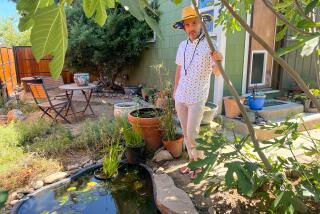Gardening : Hydroponic Garden Really Makes Water Work
Hydroponic gardening is an idea that has never been more timely, says Steve Hollister, especially in this period of drought.
Wait a minute--doesn’t hydroponic gardening require water, not save it?
Sure, says Hollister, but it uses only a fraction of the water necessary to maintain a garden planted in soil.
For those not familiar with hydroponic, or soil-less, gardening, it works this way. Plants are grown in hydroponic units that usually feature beds of gravel, or a similar inert growing medium, through which water containing plant nutrients is pumped periodically.
Hollister, who owns Hollister’s Hydroponics in Irvine, says the reason water is saved is that it is constantly recycled through a hydroponic garden. Although water is circulated through the garden several times a day, the same water is used over a two-week period. After two weeks the water has to be changed.
When asked what happens to the old water at the end of the two-week cycle, Hollister said: “It’s not wasted. It’s utilized in watering other plants in the home landscape.”
In addition to water conservation, what other advantages are there to hydroponic gardening? Hollister mentioned several. A person does not need a garden plot; hydroponic gardening can take place on a sunny patio. The gardens don’t require much space. The hassle of weeding and working the soil is eliminated, there are no soil-borne insects and plant growth is usually accelerated.
What are the limitations of hydroponic gardening? According to Hollister, there is the initial cost involved in purchasing or building the hydroponic unit, and some plants are not practical for gardening hydroponically. There can also be mechanical problems, and although much less work is involved than in a soil garden, there are certain chores that have to be done on a regular basis.
We visited with one of Hollister’s customers, Ken Tornburg of Costa Mesa. Tornburg gardens in a 3-by-12-foot unit he purchased from Hollister in 1972. In this unit, he grows a good portion of the produce he and his wife consume.
Tornburg grows the warm-season vegetables during spring and summer and the cool-season vegetables in fall and winter. He has harvested as much as 40 pounds of tomatoes a week from the unit. Although his wife would like to see him grow some flowers in the unit, Tornburg politely declines because he so enjoys the fresh vegetables.
We asked Hollister if flowers were a practical choice for hydroponic gardening. Absolutely, he said, but he added that most of his customers use the units to grow vegetables. Tomatoes are the most popular crop, he says, followed by lettuce, cucumbers, peppers, herbs, and flowers.
Hollister says some plants aren’t practical for hydroponic culture. Some, like artichokes, are too big, and others, like potatoes, are so inexpensive at the market that they don’t justify the space they require.
How much does a hydroponic unit cost? That depends on whether you opt for a simple homemade unit or a sophisticated commercially produced unit, Hollister says.
He recommends that beginners start with a simple inexpensive homemade unit. Hollister says, “You can see how you like hydroponic gardening and if you like it, you can purchase or construct a more sophisticated unit.”
Hollister’s firm sells “do it yourself” plans and kits. The kits range from $34.95 for the least expensive, to $139.95 for the deluxe kit. The inexpensive kit contains only construction plans, operation manual, polyethylene lines and PVC parts. In the deluxe kit, a pump and automatic timer are included. The customer furnishes the wood to construct the unit and the gravel that the plants grow in. Hollister notes that some companies sell ready-made units, but that these are fairly expensive.
After the unit is constructed, what are the expenses in maintaining it? Hollister says you will have to purchase plant nutrients, which are not expensive, to add to the water that circulates throughout the unit. The only other expenses are small amounts of electricity to run the pump and the cost of water.
Once the hydroponic garden is established, how much time is required to operate it successfully? Hollister says that on the average 30 to 45 minutes a week are required to properly maintain a hydroponic garden.
Hydroponic gardens are often associated with greenhouses. And particularly in colder climates, the two are utilized together. However, according to Hollister, because of our unique, mild Southern California climate, a greenhouse is not necessary for successful hydroponic gardening.
If you would like to learn more about hydroponic gardening, Hollister recommends two books: “Hydroponic Gardening” by Raymond Bridwell and “Hydroponic Food Production” by Howard Resh. Both books should be available at local libraries, Hollister says, and he sells them through his company.
Hollister’s company offers a catalogue for $1 that gives a brief introduction to hydroponic gardening, shows how to make some very simple units, and lists his products. Write to Hollister’s Hydroponics, P.O. Box 16601, Irvine, Calif. 92713; phone (714) 551-3822.






